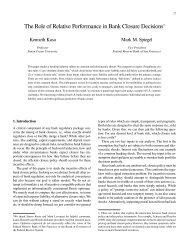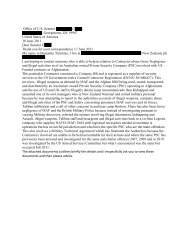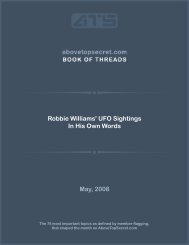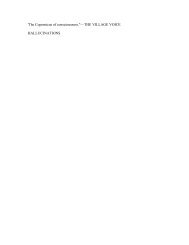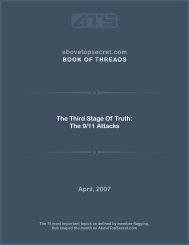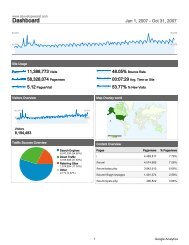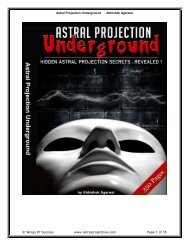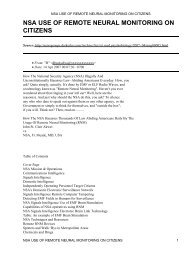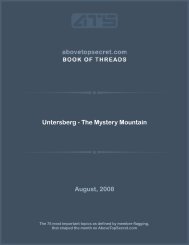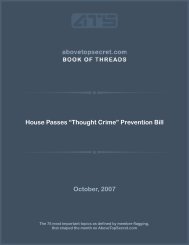<strong>of</strong> reports about "the robots" and "the Martians." The consensus among UFO researchers in the1960s, including myself, was that we were probably dealing with space visitors. The idea, at thetime, was revolutionary. Scientists like Carl Sagan pointed out that space visitations, if theyoccurred at all, would be very rare. Other scientists, like Donald Menzel, rejected the whole idea,because even the nearest stars are too far away for interstellar travel to be feasible, even at highspeed. Sagan's and Menzel's arguments are valid only if one assumes that their science has notsuperseded in any fundamental way the limitations <strong>of</strong> our own science, that they have found nomeans <strong>of</strong> propagating information faster than the speed <strong>of</strong> light, and that they are using the sameconcept <strong>of</strong> space-time as we are. In fact, we can make no such assumption about a spacecivilization. It could have had many centuries <strong>of</strong> development beyond our own science. Also, theycould be a lot smarter.The real question is, does the "spacecraft" hypothesis explain to our satisfaction the facts <strong>of</strong> theUFO phenomenon as we know them today? The answer is a definite and resounding no. Thecontactees and their friends will challenge this answer in many ways: "What about the messages weare receiving through 'channels' and through automatic writing, assuring us that the vehicles comefrom other worlds? What about our own observations <strong>of</strong> landings in deserts and remote areas? Whatabout the strange scars left on the bodies <strong>of</strong> the abductees who remember being medically examinedaboard the craft?"And what about the evidence <strong>of</strong> the "star map" seen by contactee Betty Hill aboard the UFO thatabducted her? What about the thousands <strong>of</strong> reports <strong>of</strong> landings that have been made around theentire world? Let us examine closely this so-called evidence.There Are Too Many LandingsThe first argument against the idea <strong>of</strong> flying saucers as spacecraft lies, oddly enough, in the largenumber <strong>of</strong> verified, unexplained sightings. In my own files I have selected approximately twothousand documented cases <strong>of</strong> close encounters from every country on earth, many <strong>of</strong> theminvolving occupants <strong>of</strong> various sizes and shapes. It may seem that two thousand cases in sometwenty years is not a very large number, but we are talking only about the cases that were actuallyreported. It is possible to calculate how many landings this represents if, as the contactees claim,UFOs are spacecraft whose occupants happened to be surprised by witnesses who wandered ontothe scene as the craft was being repaired or as the crew was conducting some exploration <strong>of</strong> ourplanet. To make this estimation we must take into account three factors: the time <strong>of</strong> the sighting, theprobability that it will be reported, and the place <strong>of</strong> the event.Most landings are reported to take place after 6:00 P.M. The frequency distributions my computerstudies have disclosed for every continent show this activity peaking at about 10:30 P.M.,decreasing sharply after that time, and increasing again just before dawn. There are few reports after6:00 A.M. What could this mean? That the activity <strong>of</strong> the objects is nocturnal by nature and bychoice. Then why do the reports decrease in frequency around midnight? Simply because people goto bed: after 10:30 P.M. the number <strong>of</strong> potential witnesses is severely reduced. Then let us ask howmany reports would we have if people did not go to bed but stayed outside to watch these so-calledspacecraft. The answer is about thirty thousand. We would have to multiply the number <strong>of</strong> cases bya factor <strong>of</strong> fifteen, and the actual peak would then be between 1:00 and 3:00 A.M.Now, this last figure does not begin to approximate the actual number <strong>of</strong> events, because we knowfrom many independent studies that only one case in ten ever gets reported. Then we should havenot thirty thousand but three hundred thousand cases in our files! But this still isn't the whole story:most landings occur in unpopulated areas, away from dwellings. If the earth's population weredistributed evenly instead <strong>of</strong> being concentrated in city areas, how many reports would we have?Again, taking a conservative multiplying factor <strong>of</strong> ten leads us to the staggering conclusion that theUFOs, if they are spacecraft engaged in a general survey <strong>of</strong> our planet, must have landed here n<strong>of</strong>ewer than three million times in two decades! [I first reported this finding ten years ago in a paper
delivered before the American Institute <strong>of</strong> Aeronautics and astronautics. This "law <strong>of</strong> the times" hasnow been verified by other researchers in various countries, and the total number <strong>of</strong> estimatedlandings has been repeatedly confirmed.]This number is totally absurd. Using a single probe the size <strong>of</strong> a beer keg in orbit a thousand milesabove the earth, human technology as it exists today would be able to capture in a few weeks most<strong>of</strong> the important facts about the planet's geography, weather, vegetation, and culture. Given theearth's abundant emission <strong>of</strong> radio and television programs for the last fifty years, even thedeployment <strong>of</strong> such a space probe might be unnecessary.This is one <strong>of</strong> the little-recognized facts <strong>of</strong> the UFO problem that any theory has yet to explain. Thetheory <strong>of</strong> random visitation does not explain it. Either the UFOs select their witnesses forpsychological or sociological reasons, or they are something entirely different from space vehicles.In either case, their appearances are staged!The Super Physics <strong>of</strong> the UFOsThe following unexplained sightings have been extracted from dozens <strong>of</strong> similar cases in my files.March 1954, Santa Maria, Brazil. A man observed two occupants <strong>of</strong> a football-shaped craft whospoke in a strange language. The craft vanished silently and instantly.June 1962, Verona, Italy. Following a UFO observation, a woman was awakened by a feeling <strong>of</strong>intense cold and saw a being with a bald head near the house. She called other witnesses, and allsaw the apparition shrink and vanish on the spot "like a TV image when the set is turned <strong>of</strong>f."October 1963, Whidbey Island, Washington State. A middle-aged woman saw a strange craft withthree figures inside. It tilted, partially sank into the ground, grew in size, and departed with a flash.November 1968, France. A doctor saw two large disk-shaped objects merge into one, and the singleobject sent a beam <strong>of</strong> light in his direction. It vanished with a sort <strong>of</strong> explosion, leaving a cloud thatdissipated slowly.Consider what these sightings have in common. In each case the so-called spacecraft did notdisappear by moving away, even at high speed. It simply vanished on the spot, or it slowly fadedaway like the Cheshire cat, sometimes leaving behind a whitish cloud, sometimes also producingthe sound <strong>of</strong> an explosion. In other cases, UFOs have been reported to enter the ground.I hardly need to point out that this behavior is contrary to what physical objects do and quiteimpossible to duplicate with our current spacecraft technology. It is the behavior <strong>of</strong> an image, or aholographic projection. Yet at other times the objects have left material traces. There may be amachine involved, but a machine that remains out <strong>of</strong> view <strong>of</strong> the witnesses, who see only what it isprojecting. When we go to the movies, we look at the objects and the people on the screen; we donot stare at the projector. Besides, a single physical machine (a camera) can trigger millions <strong>of</strong>similar experiences in the people who watch the resulting film projection.Most witnesses are not primarily reporting an object or a craft; they are reporting a light, a massive,multicolored, intense, pulsating light, a playful, fascinating, impressive, hypnotic light that isaccompanied by strange sounds. In other words, UFOs may be unidentified, but they are not flying,as birds and airplanes fly, and they do not always behave as material objects.How much do we know from the avilable scientific literature about the effects <strong>of</strong> strong, pulsed,colored lights and other electromagnetic radiations, such as microwaves and gamma rays, on thehuman brain and on the major nerves? Pitifully little. Until this area is fully explored, we will onlyhave a poor understanding <strong>of</strong> the physics <strong>of</strong> UFOs.The Absurd Humanoids<strong>Contact</strong>ees tell us they have met the denizens <strong>of</strong> other planets. In some cases the beings turned outto be robots or dwarfs in diving suits, but in most incidents they were humanoid, and they could
- Page 3 and 4:
Foreword by Whitley StrieberThere a
- Page 5 and 6:
It is sad that, as the twentieth ce
- Page 7 and 8:
PART ONE: THE ALIEN CHRONICLESIn th
- Page 9 and 10:
lot about it, but nobody said 'Let'
- Page 11 and 12:
The resemblance of the Dogu statues
- Page 13:
various forms of error worship unde
- Page 16 and 17:
them. These apparitions are scarce,
- Page 18 and 19:
was again shot at. Another creature
- Page 20 and 21:
The story is fantastic. Yet it remi
- Page 22 and 23:
their virginity in the sanctuaries
- Page 24 and 25:
A letter from a British woman begin
- Page 26 and 27:
The recollections of the legionnair
- Page 28 and 29:
lades. In less time than it takes t
- Page 30 and 31:
e called Smith said: "No, we cannot
- Page 32 and 33:
Celtic legends, along with the docu
- Page 34 and 35:
probably took place in the second p
- Page 36 and 37:
Australian Air Force Intelligence p
- Page 38 and 39:
ings in the fields and prairies?One
- Page 40 and 41:
From behind the object, two beings
- Page 42 and 43:
"in smooth English." They did not s
- Page 44 and 45:
to four feet tall, dressed in white
- Page 46 and 47:
expectations as if they were mere t
- Page 48 and 49:
came out of it, but this person was
- Page 50 and 51:
6. When men did not inhabit most of
- Page 52 and 53:
the negative reactions of scientist
- Page 54 and 55:
other in appearance, dress, mode of
- Page 56 and 57:
saw that they had made a grin, he h
- Page 58 and 59:
and rode out after dark in search o
- Page 60 and 61:
sighting, and the Sonny Desvergers
- Page 62 and 63:
PART TWO: ANOTHER REALITYDuring the
- Page 64 and 65:
pencil in a buttonhole with a piece
- Page 66 and 67:
short perpendicular line on each en
- Page 68 and 69:
sudden displacement of warm air or
- Page 70 and 71:
popular today. But a second - and e
- Page 72 and 73:
ecorded about 1825 in the Vale of N
- Page 74 and 75:
The ikal of the Tzotzils flies thro
- Page 76 and 77:
the door, he turned and recieved a
- Page 78 and 79:
If Stewart came back today, he woul
- Page 80 and 81:
The devil does not have a body. The
- Page 82 and 83:
interested in the social implicatio
- Page 84 and 85: Very well, little son. Come back to
- Page 86 and 87: measure. But the phenomenon does ap
- Page 88 and 89: and physical, to determine whether
- Page 90 and 91: previous year. But the fact remains
- Page 92 and 93: Do Not Report This!Accounts such as
- Page 94 and 95: least one occasion, experienced lev
- Page 96 and 97: deep unconscious level of the symbo
- Page 98 and 99: much as twenty hours a day, and in
- Page 100 and 101: against me as I stood bracing mysel
- Page 102 and 103: another one, but this was very defi
- Page 104 and 105: not natural, was witnessed by perso
- Page 106 and 107: The predicted miracle took place as
- Page 108 and 109: The phenomenon, it seems, could not
- Page 110 and 111: in the final analysis.Many of us wi
- Page 112 and 113: already surrounded....I was told wh
- Page 114 and 115: Since the publication of my earlier
- Page 116 and 117: ”A bright flash”Fatima, May 13,
- Page 118 and 119: The Invisible CollegeAfter some thi
- Page 120 and 121: the Air Force met in Dallas and dis
- Page 122 and 123: panel of scientists could rapidly b
- Page 124 and 125: it had been hovering there was now
- Page 126 and 127: like piezo-electricity, or static e
- Page 128 and 129: the group teachings and advice. The
- Page 130 and 131: This is a frightening view, one tha
- Page 132 and 133: John McCoy, who coauthored with Wil
- Page 136 and 137: eathe our air. They walked normally
- Page 138 and 139: the designation Wolf 424.The myster
- Page 140 and 141: a scar or a mark. The authorities w
- Page 142 and 143: esearches might have a bearing on a
- Page 144 and 145: me undeniable) and as psychic devic
- Page 146 and 147: extraterrestrial theory is not stra
- Page 148 and 149: the universe summarizes the problem
- Page 150 and 151: About the AuthorAn astrophysicist b



